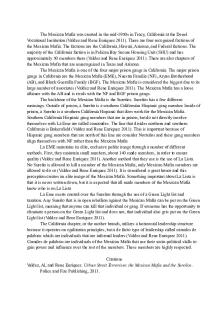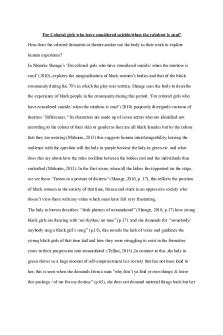Post task Angie Mora - Post tarea PDF

| Title | Post task Angie Mora - Post tarea |
|---|---|
| Author | Vanne Mora Mancera |
| Course | Teoría Electromagnética |
| Institution | Universidad Nacional de Colombia |
| Pages | 14 |
| File Size | 1.3 MB |
| File Type | |
| Total Downloads | 36 |
| Total Views | 836 |
Summary
Post task - Final activity Individual work formatAngie Mora Mancera Group 8 1010215197UNIVERSIDAD NACIONAL ABIERTA Y A DISTANCIA UNADEscuela de Ciencias Básicas, Tecnología e Ingeniería Teoría Electromagnética y Ondas 202 1 16-ActivityApplication exercises:For the development of the following exerci...
Description
Post task - Final activity Individual work format
Angie Mora Mancera Group 8 1010215197
UNIVERSIDAD NACIONAL ABIERTA Y A DISTANCIA UNAD Escuela de Ciencias Básicas, Tecnología e Ingeniería Teoría Electromagnética y Ondas 2021 16-04
Exercises development Activity Application exercises: For the development of the following exercises, note that 𝐺𝐺 corresponds to the group number and 𝐶𝐶𝐶 to the last 3 digits of the identification number.
1. An electromagnetic wave of 𝑓 = 197 𝑀𝐻𝑧 is transmitted from the bottom of a ship to a receiver located at 𝑝 = 1 𝐾𝑚 depth. The wave is emitted with an advance angle of 𝑎 = 13°. Determine the time it takes for the wave to reach the receiver.
Figure 1: wave propagation in open media. Image recovered from https://www.ee.co.za/article/new-economics-marineenvironmental-monitoring.html
For development, follow the following steps: a. Calculate the tangent of losses 𝑇𝑎𝑛(𝛿) = 𝜎/𝜔𝜀. 𝑇𝑎𝑛(𝛿) =
𝜎 𝜎 4 𝑆/𝑚 = = 6 𝜔𝜀 2𝜋𝑓εr ε𝑜 2𝜋 ∗ 197𝑥 10 𝐻𝑧 ∗ 80 ∗ 8.8542x10−12 𝐶 2 /N𝑚2
𝑇𝑎𝑛(𝛿) = 4.562202752 𝛿 = 𝑇𝑎𝑛−1(4.562202752) = 77.63°
b. Classify the behavior of the medium. Dielectrics with losses Media 1. Perfect dielectrics
Tan(δ)
(Not dissipative)
2. Good insulators
(Lost low dielectric)
3. Dissipative dielectrics
(Dielectrics with losses)
4. Good conductors
(Good conductors)
5. Perfect conductors
(Perfect conductors)
δ [°]
Tan(δ) = 0
δ = 0°
0 < Tan(δ) 10
δ = 90°
c. Calculate the propagation parameters of the wave 𝛾, 𝛼 and 𝛽.
(gamma) 𝜔 = 2𝜋𝑓 = 2𝜋𝑓 = 2𝜋(197𝑀𝐻𝑧) = 1237787505.514𝐻𝑧 𝜇 = 𝜇𝑟 𝜇𝑜 = 1 ∗ 1.2566x10−6 = 1.2566x10−6 𝜀 = εr ε𝑜 = 80 ∗ 8.8542x10−12 𝐶 2 /N𝑚2 = 7.08336x10−10 𝛾 = √𝑗𝜔𝜇(𝜎 + 𝑗𝜔𝜀) 𝛾 = √[𝑗(1237787505.514𝐻𝑧)(1.2566𝑥10−6)][4 + 𝑗(1237787505.514𝐻𝑧)(7.08336𝑥10−10 )]
𝛾 = 50.0779571394631 + 62.2435369177656𝑖
(Alpha) 𝛼 = 50.0779571394631𝑁𝑝/𝑚
(Beta) 𝛽 = 62.2435369177656𝑅𝑎𝑑/𝑚
d. Calculate the propagation speed of the 𝑉𝑝 wave. 𝑉𝑝 = 𝜔/𝛽 𝑣𝑝 =
𝜔 1237787505.514𝐻𝑧 = 𝛽 62.2435369177656𝑅𝑎𝑑/𝑚
𝑣𝑝 = 19886201.3119𝑚/𝑠
e. Calculate the distance 𝑑 between the ship and the receiver. 𝑑 = 𝑃/𝑐𝑜𝑠(𝑎). 𝑑=
𝑃 100000𝑚 = 𝐶𝑜𝑠(𝑎) 𝐶𝑜𝑠(13°)
𝑑 = 102630.41077m
f. Based on 𝑉𝑝 and 𝑑 determine the time 𝑡 of the route. 𝑑 = 𝑡 ∗ 𝑉𝑝 𝑑 = 𝑡 ∗ 𝑉𝑝
𝑡= 𝑡=
𝑑 𝑉𝑝
102630.41077m 19886201.3119𝑚/𝑠
𝑡 = 0.005160𝑠
Interpretation: according to the concepts explored, explain the meaning of the value obtained for 𝑇𝑎𝑛(𝛿) and 𝑡. The loss tangent allows me to identify the behavior in the middle. in this case the propagation medium is a dielectric with losses. t, is the 5.16ms, is the time it takes for the wave to propagate, when it is between the ship and the receiver
2. From an airplane, which is ℎ1 = 1250 𝑚 high, a communication signal 𝑓 = 197 𝑀𝐻𝑧 is emitted to a submarine that is ℎ2 = 800 𝑚 deep, the angle of incidence of the signal on the sea surface is 𝑎 = (13)°. Determine the time it takes for the signal to reach the submarine. Note that 𝐶𝑜 = 3𝑥108 𝑚/𝑠.
Figure 2: wave propagation in bounded open media. Image recovered from https://byjus.com/physics/characteristics-of-soundwavesamplitude/ For development, follow the following steps: refractive indices: 𝑛1(𝑎𝑖𝑟𝑒) = 1.0002926
𝑛2(𝑎𝑔𝑢𝑎) = 1.33
a. Calculate the distance between the plane and the point of incidence at sea 𝑑1 = ℎ1 /𝑠𝑒𝑛(𝑎). 𝑑1 = 𝑑1 =
ℎ1 𝑠𝑒𝑛(𝑎)
1250𝑚 𝑠𝑒𝑛(13°)
𝑑1 = 5556.7643𝑚
b. Calculate the velocity of propagation of the wave 𝑉𝑝1 in the air (𝑉𝑝1 = 𝐶𝑜/𝑛), where 𝑛 is the refractive index of air.
𝑉𝑝1 =
𝑉𝑝1 =
𝐶𝑜 𝑛
3𝑥 108 𝑚/𝑠 1.0002926
𝑉𝑝1 = 299124760.9494𝑚/𝑠
c. Using Snell's Law, calculate the angle of refraction of the wave in the sea. 𝑛1 𝑠𝑒𝑛 (𝜃𝑎′ ) = 𝑛2 𝑠𝑒𝑛(𝜃𝑏 ) 𝜃𝑏 = 𝑠𝑒𝑛−1 ( 𝜃𝑏 = 𝑠𝑒𝑛−1 ( 𝜃𝑏 = 47.12°
𝑛1 𝑠𝑒𝑛(𝜃𝑎′ )) 𝑛2
1.0002926 𝑠𝑒𝑛(77°)) 1.33
d. Calculate the distance between the point of incidence in the sea and the submarine. 𝑑1 = 𝑑1 =
ℎ2 𝑐𝑜𝑠(𝜃𝑏 )
800𝑚 𝑐𝑜𝑠(47.12°)
𝑑1 = 1145.6664𝑚
e. Calculate the propagation speed of the wave 𝑉𝑝2 at sea (take 𝑉𝑝 from exercise 1).
𝑣𝑝2 =
𝜔 1237787505.514𝐻𝑧 = 𝛽 62.2435369177656𝑅𝑎𝑑/𝑚
𝑣𝑝2 = 19886201.3119𝑚/𝑠 f. Based on 𝑉𝑝1 and 𝑑1 determine the time 𝑡1 of the first path (𝑡1 = 𝑑1 /𝑉𝑝1 ). 𝑡1 =
𝑑1 5556.7643𝑚 = 𝑉𝑝1 299124760.9494𝑚/𝑠
𝑡1 = 0.0000185767𝑠
g. Based on 𝑉𝑝2 and 𝑑2 determine the time 𝑡2 of the second path (𝑡2 = 𝑑2 /𝑉𝑝2 ). 𝑡2 =
𝑑2 1145.6664𝑚 = 𝑉𝑝2 19886201.3119𝑚/𝑠
𝑡2 = 0.0000576111235𝑠
h. Calculate the total time of the route 𝑡 = 𝑡1 + 𝑡2 .
𝑡 = 0.0000185767𝑠1 + 0.0000576111235𝑠
𝑡 = 76.18𝜇𝑠
Interpretation: according to the concepts explored, explain the meaning of the value obtained for 𝑉𝑝1 , 𝑉𝑝2 and 𝑡. We can see that the speed of the wave in the air is much higher than in the sea, since the index of reflation of the air is 1, and that of the sea is 1.33, We can conclude that the wave travels faster in the air, and that the time it takes to reach the submarine is 76.18𝜇𝑠
3. A lossless transmission line has a characteristic impedance of 𝑍0 = 75Ω, a length of 𝐿 = 5𝑚 and is excited by a signal of 𝑓 = 500 𝑀𝐻𝑧. The line is connected to an antenna with load impedance 𝑍𝐿 = (45 + 𝑗45)Ω. Taking into account that 𝑉𝑝 = 3𝑥107 𝑚/𝑠, calculate: a. Wavelength 𝜆. 𝜆=
𝑣𝑝 3𝑥107 𝑚/𝑠 = 𝑓 500 𝑀𝐻𝑧
𝜆 = 0.06𝑚
b. Electrical length ℓ.
ℓ=
𝐿 5𝑚 = 𝜆 0.06𝑚
ℓ = 83.333333
c. Input impedance 𝑍𝑖𝑛 . 𝑧𝑖𝑛 = 𝑧0 ∗
𝑧𝐿 + 𝑗𝑧0 𝑇𝑎𝑛(2𝜋𝑙) 𝑧0 + 𝑗𝑧𝐿 𝑇𝑎𝑛(2𝜋𝑙 )
𝑧𝑖𝑛 = 75Ω ∗
(45 + 𝑗45)Ω + 𝑗 ∗ 75Ω ∗ 𝑇𝑎𝑛(2 ∗ 𝜋 ∗ 0.06) 75Ω + 𝑗 ∗ (45 + 𝑗45)Ω ∗ 𝑇𝑎𝑛(2 ∗ 𝜋 ∗ 0.06)
𝑧𝑖𝑛 = 4.6686 + 2.031𝑖
d. Reflection coefficient Γ (magnitude and phase). Γ= Γ=
𝑍𝐿 − 𝑍𝑜 𝑍𝐿 + 𝑍𝑜
(45 + 𝑗45)Ω − 75Ω (45 + 𝑗45)Ω + 75Ω
Γ = 0.42 ≮ 103.13° e. VSWR. VSWR = VSWR =
1 + |Γ| 1 − |Γ|
1 + |0.42| 1 − |0.42|
VSWR = 2.44
f. Check the results c, d and e with the Smith 4.1 software.
Figure 3: Transmission line.
Interpretation: according to the concepts explored, explain the meaning of the value obtained for 𝑍𝑖𝑛 , Γ and 𝑉𝑆𝑊𝑅 . We can see that the wave has enough power to reach its destination, thanks to VSWR this shows that Zin is adequate to transport the wave
References
Chen, W. (2005). The Electrical Engineering Handbook. Boston: Academic Press, (pp. 525-551). Recovered from http://bibliotecavirtual.unad.edu.co:2048/login?url=http://search.ebscoh ost.com/login.aspx?direct=true&db=nlebk&AN=117152&lang=es&site=ehostlive&ebv=EB&ppid=pp_525
Joines, W., Bernhard, J., & Palmer, W. (2012). Microwave Transmission Line Circuits. Boston: Artech House, (pp. 23-68). Recovered from http://bibliotecavirtual.unad.edu.co:2051/login.aspx?direct=true&db=nle bk&AN=753581&lang=es&site=eds-live&ebv=EB&ppid=pp_23
Hierauf, S. (2011). Understanding Signal Integrity. Boston: Artech House, Inc. Chapter 6, 7, 11. Recovered from http://bibliotecavirtual.unad.edu.co:2051/login.aspx?direct=true&db=nle bk&AN=345692&lang=es&site=eds-live&ebv=EB&ppid=pp_49
Impedance Matching Networks. (2001). Radio-Frequency & Microwave Communication Circuits, (pp. 146-188). Recovered from http://bibliotecavirtual.unad.edu.co:2051/login.aspx?direct=true&db=aci &AN=14528229&lang=es&site=eds-live...
Similar Free PDFs

Post task Angie Mora - Post tarea
- 14 Pages

Post Tarea - Evaluación Final
- 19 Pages

Post Tarea Grupo 212018 48
- 19 Pages

Post lab - Post Lab 1
- 2 Pages

Discussion Post
- 1 Pages

Post lab 10 - Post lab 10
- 3 Pages

Discussion Post
- 2 Pages

Week 2 Post - Week 2 Post
- 1 Pages

Post lab 2 - post lab orton
- 8 Pages

Post lab 3 - post lab orton
- 13 Pages

Post4 - post
- 2 Pages
Popular Institutions
- Tinajero National High School - Annex
- Politeknik Caltex Riau
- Yokohama City University
- SGT University
- University of Al-Qadisiyah
- Divine Word College of Vigan
- Techniek College Rotterdam
- Universidade de Santiago
- Universiti Teknologi MARA Cawangan Johor Kampus Pasir Gudang
- Poltekkes Kemenkes Yogyakarta
- Baguio City National High School
- Colegio san marcos
- preparatoria uno
- Centro de Bachillerato Tecnológico Industrial y de Servicios No. 107
- Dalian Maritime University
- Quang Trung Secondary School
- Colegio Tecnológico en Informática
- Corporación Regional de Educación Superior
- Grupo CEDVA
- Dar Al Uloom University
- Centro de Estudios Preuniversitarios de la Universidad Nacional de Ingeniería
- 上智大学
- Aakash International School, Nuna Majara
- San Felipe Neri Catholic School
- Kang Chiao International School - New Taipei City
- Misamis Occidental National High School
- Institución Educativa Escuela Normal Juan Ladrilleros
- Kolehiyo ng Pantukan
- Batanes State College
- Instituto Continental
- Sekolah Menengah Kejuruan Kesehatan Kaltara (Tarakan)
- Colegio de La Inmaculada Concepcion - Cebu




